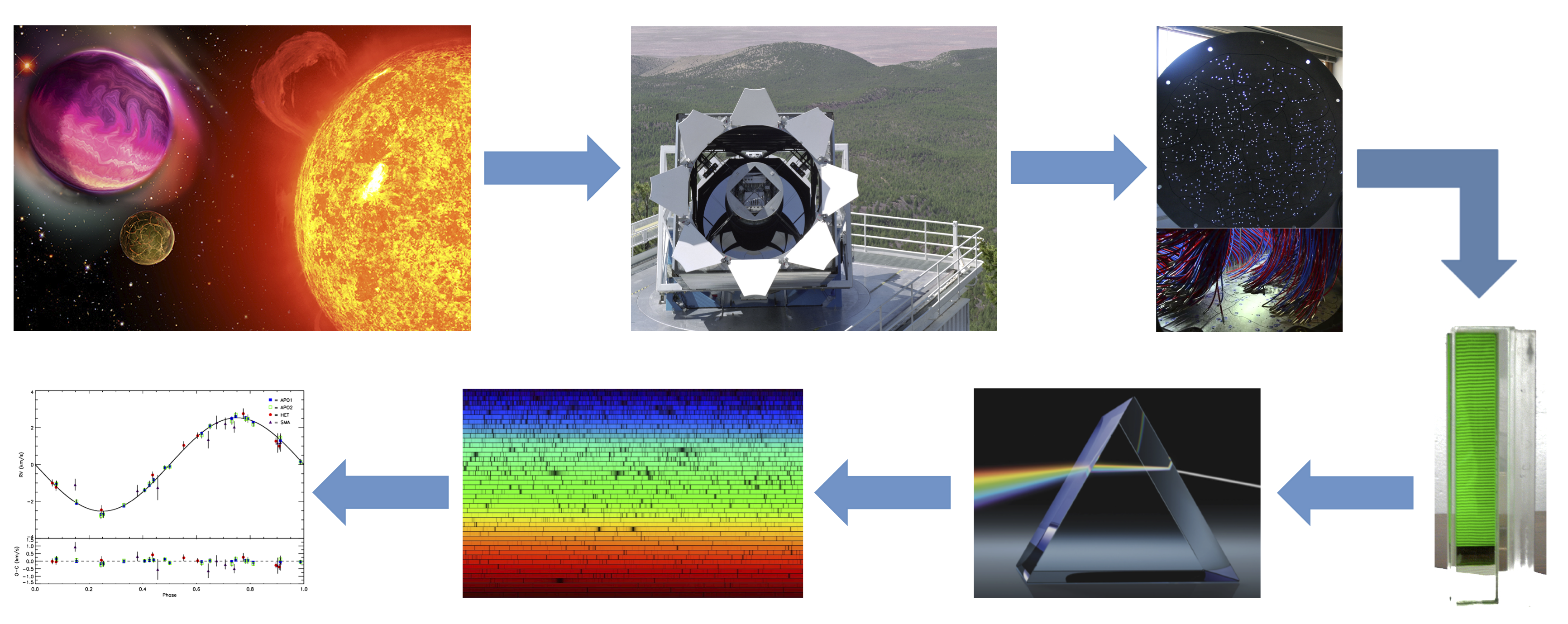MARVELS - Searching For Gas Giant Planets and Low Mass Companions Around 10,000 Sun-Like Stars

Project Description
Planets are common in the universe, many of the detected planets are gas giant planets, like the Jupiter in the solar system. To understand their formation and evolution is the key to understand habitable world. For example, life on Earth may relate to the early evolution of the Jupiter and Saturn. Also, some gas giant planets form beyond the snow line, where temperature is so low that water condenses to ice. The planets then migrate in, the migration process greatly affects the formation and evolution of rocky planets, where we think life may exist in the form as we know. Therefore, studying the the occurrence rate of gas giant planets and its correlation with stellar properties is crucial. The study requires observing many stars to obtain a statistical meaningful sample, which can be achieve by the Multi-object APO Radial Velocity Exoplanet Large-area Survey (MARVELS) project. The MARVELS project surveyed ~10,000 sun-like stars, an unprecedentedly large sample compared to previous planet searches. Its unique multi-object capability allows observing 60 stars simultaneously, which significantly improves the observing efficiency.
The way MARVELS works is illustrated in the figure above. Light from distant stars travels many light years to reach the SDSS 2.5m telescope. The light of each stars is transmitted via a fiber on a metal plate on the telescope focal plane. One the other end of the fiber, star light propagates through a Michelson interferometer and a grating that disperses the light. After dispersion, the star light forms a spectrum with many absorption lines. These lines are used to measure the radial velocities of stars due to the Doppler effect: wavelength becomes bluer when an object is approaching the observer, and vice versa. The Doppler effect is caused by a unseen planet orbiting around a star. The planet exerts a gravitationally tug on the star and causes the star wobbling, exhibiting radial velocity variation in a sinusoidal form.
My contribution to the project is mainly the Michelson interferometer. The interferometer is unique part of the instrument, which boost the Doppler sensitivity by a factor of 2-3. I established the significant role of the interferometer from a simulation point of view. In the lab, I helped to design and build the interferometer. Since the interferometer is such a intricate and sensitive part, I was responsible to test and calibrate the interferometer. I measured its optical path difference, which is a key parameter to convert the measurable to radial velocity. I measured its field of view and optical throughput, which are essential for the sensitivity and thus the performance of the whole instrument. During the operation of MARVELS, I took another test interferometer to the Apache Point Observatory to study the time variant of the interferometer.
Unfortunately, the MARVELS instrument has not discovered any gas giant planets yet. Instead, the instrument made many other interesting discoveries. Among them, brown dwarfs are the most notable. Brown dwarfs are too light-weighted to become stars, and yet too massive to be called planets. They represent the boundary condition for planet and star formation. Over the years, we have had many discoveries of brown dwarfs, which represent a rare population of sub-stellar objects.
Instrumentation Publications
Ji Wang, Jian Ge, Xiaoke Wan, Brian Lee, Nathan De Lee. Accurate Group-Delay Measurement for Radial-Velocity Instruments Using the Dispersed Fixed-Delay Interferometer Method.. 2012, PASP, 124, 598
Ji Wang, Jian Ge, Xiaoke Wan, Nathan De Lee, and Brian Lee. Accurate Group Delay Measurement for Radial Velocity Instruments Using the Dispersed Fixed Delay Interferometer Method. II. Application of Heterodyne Combs Using an External Interferometer Filter.. 2012, PASP, 124, 1159
Xiaoke Wan, Ji Wang, Jian Ge. Accurate measurement of interferometer group delay using field-compensated scanning white light interferometer. 2010, Applied Optics, Vol. 49 Issue 29, pp. 5645-5653
Ji Wang, Xiaoke Wan, Jian Ge. Development of Monolithic Michelson Interferometer for RV measurement in IR. 2010, SPIE, 7734, 3Q
Xiaoke Wan, Ji Wang, Jian Ge. Resolving fringe ambiguities of a wide-field Michelson interferometer using visibility measurements of a noncollimated laser beam. 2009, Applied Optics, Vol. 48 Issue 26, pp. 4909-4916
Science Publications
Nathan De Lee, et al. Very Low Mass Stellar and Substellar Companions to Solar-like Stars from MARVELS. V. A Low Eccentricity Brown Dwarf from the Driest Part of the Desert, MARVELS-6b. 2013, AJ, 145, 155
Peng Jiang, et al. Very Low Mass Stellar and Substellar Companions to Solar-like Stars from MARVELS. IV. A Candidate Brown Dwarf or Low-mass Stellar Companion to HIP 67526. 2013, AJ, 146, 65
Bo Ma, et al. Very-low-mass Stellar and Substellar Companions to Solar-like Stars from Marvels. III. A Short-period Brown Dwarf Candidate around an Active G0IV Subgiant. 2013, AJ, 145, 20
Scott W. Fleming, et al. Very Low Mass Stellar and Substellar Companions to Solar-like Stars from MARVELS. II. A Short-period Companion Orbiting an F Star with Evidence of a Stellar Tertiary and Significant Mutual Inclination. 2012, AJ, 144, 72
John P. Wisniewski, et al. Very Low Mass Stellar and Substellar Companions to Solar-like Stars from MARVELS. I. A Low-mass Ratio Stellar Companion to TYC 4110-01037-1 in a 79 Day Orbit. 2012, AJ, 143, 107
Brian L. Lee, et al. MARVELS-1b: A Short-period, Brown Dwarf Desert Candidate from the SDSS-III Marvels Planet Search. 2011, ApJ, 728, 32
Ji Wang, Jian Ge, Peng Jiang, Bo Zhao. Fundamental Performance of a Dispersed Fixed Delay Interferometer in Searching for Planets around M Dwarfs.. 2011, ApJ, 738, 132